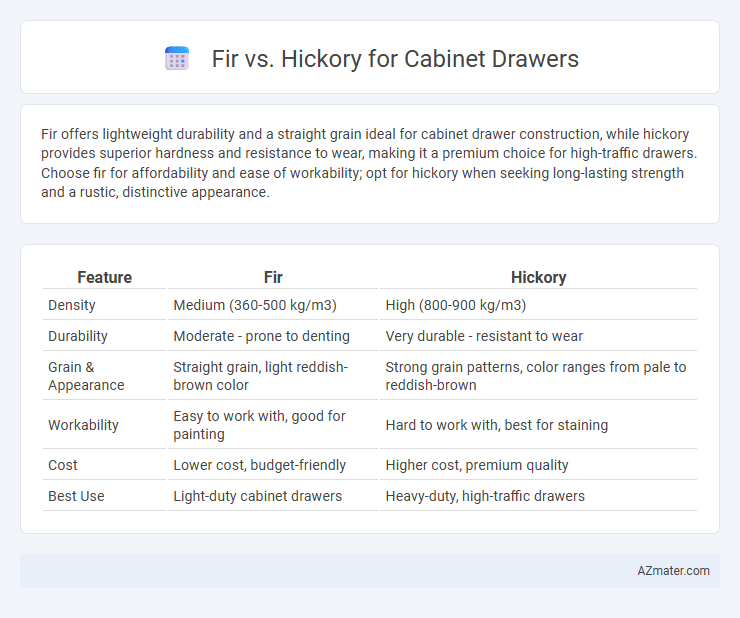Fir offers lightweight durability and a straight grain ideal for cabinet drawer construction, while hickory provides superior hardness and resistance to wear, making it a premium choice for high-traffic drawers. Choose fir for affordability and ease of workability; opt for hickory when seeking long-lasting strength and a rustic, distinctive appearance.
Table of Comparison
| Feature | Fir | Hickory |
|---|---|---|
| Density | Medium (360-500 kg/m3) | High (800-900 kg/m3) |
| Durability | Moderate - prone to denting | Very durable - resistant to wear |
| Grain & Appearance | Straight grain, light reddish-brown color | Strong grain patterns, color ranges from pale to reddish-brown |
| Workability | Easy to work with, good for painting | Hard to work with, best for staining |
| Cost | Lower cost, budget-friendly | Higher cost, premium quality |
| Best Use | Light-duty cabinet drawers | Heavy-duty, high-traffic drawers |
Fir vs Hickory: Key Differences for Cabinet Drawers
Fir wood offers a lighter color and smoother grain ideal for painted or stained cabinet drawers, while hickory provides superior hardness and striking grain patterns perfect for rustic or high-traffic drawers. Fir tends to be more affordable and easier to work with, but hickory excels in durability and resistance to dents and wear, making it suitable for long-lasting cabinetry. Choosing between fir and hickory depends on desired aesthetics, durability requirements, and budget constraints in cabinet drawer construction.
Wood Hardness: Fir and Hickory Compared
Fir wood has a Janka hardness rating of approximately 660, making it relatively soft and easier to machine or shape for cabinet drawers. Hickory boasts a significantly higher Janka hardness rating around 1820, providing superior resistance to dents and wear in high-traffic drawer use. Choosing hickory ensures enhanced durability and longevity, while fir offers a more cost-effective and workable option for cabinetry.
Appearance and Grain Patterns
Fir wood for cabinet drawers offers a straight, uniform grain with a light, yellowish-brown hue that provides a smooth and consistent appearance. Hickory features a more striking and varied grain pattern, often showcasing bold contrasts with rich tones ranging from pale cream to deep reddish-brown, giving drawers a rustic and dynamic look. The pronounced grain variations in hickory create a unique aesthetic, while fir's subtle pattern suits minimalist and contemporary cabinetry styles.
Durability and Longevity
Hickory is renowned for its exceptional durability and strength, making it highly resistant to dings, dents, and wear in cabinet drawers, ensuring long-lasting performance. Fir, while more affordable and easier to work with, has a softer texture and is prone to dents and scratches over time, which can reduce its longevity in high-usage environments. The dense grain structure of hickory significantly enhances drawer stability and lifespan, making it the preferred choice for cabinets requiring enhanced durability.
Cost Considerations: Fir vs Hickory
Fir wood offers a cost-effective option for cabinet drawers, often priced significantly lower than hickory due to its widespread availability and faster growth rate. Hickory, known for its exceptional hardness and durability, commands a higher price because of its dense grain and limited supply, making it a premium choice for long-lasting cabinetry. Budget-conscious homeowners seeking quality with affordability typically favor fir, while those prioritizing strength and aesthetic longevity invest in hickory despite the increased cost.
Workability and Installation Differences
Fir wood offers superior workability for cabinet drawers due to its straight grain and softer texture, which allows for easier cutting, sanding, and shaping. Hickory is denser and harder, making it more durable but challenging to machine and requiring more precise handling during installation to avoid splitting. The installation of fir drawers benefits from its lighter weight and smooth surface, while hickory requires pre-drilling and stronger fasteners to ensure secure assembly within cabinetry.
Staining and Finishing: Results with Each Wood
Fir wood offers a smooth surface that readily absorbs stains, resulting in an even, warm finish ideal for traditional-style cabinet drawers. Hickory's dense grain creates a naturally rustic look, and while it can be stained, the finish often showcases pronounced grain patterns, adding character and depth to the drawer's appearance. Both woods benefit from sealing and finishing with polyurethane or varnish to enhance durability and protect against moisture.
Environmental Impact and Sustainability
Fir wood, sourced from fast-growing trees, offers a renewable option with lower carbon emissions during harvesting compared to slower-growing hickory. Hickory, although denser and more durable, often comes from older forests, carrying higher environmental costs and reduced sustainability. Choosing fir for cabinet drawers supports responsible forestry practices and reduces the ecological footprint.
Best Uses: When to Choose Fir or Hickory
Fir is best suited for cabinet drawers in environments requiring a lightweight wood with good stability and a smooth finish, making it ideal for painted or stained cabinets in moderate use areas. Hickory, known for its exceptional hardness and durability, is preferred for heavy-use drawers in kitchens or workshops where resistance to dents and scratches is essential. Choose fir for cost-effective, softer wood applications, and hickory for premium, durable cabinetry that withstands frequent handling and wear.
Maintenance and Care for Each Wood Type
Fir cabinets require regular sealing and occasional refinishing to protect against moisture and wear, as the wood is moderately soft and prone to dents and scratches. Hickory, known for its hardness and durability, demands less frequent maintenance but benefits from periodic oiling to preserve its rich grain and prevent drying or cracking. Both woods should be cleaned with gentle, non-abrasive agents, avoiding excessive water to maintain their structural integrity and appearance over time.

Infographic: Fir vs Hickory for Cabinet Drawer
 azmater.com
azmater.com